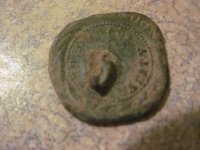ga5150
Tenderfoot
Found this last Saturday at a property that dates back to the late 1700's and also had some Civil War activity. It's almost the size of a penny. I think it was once round, but is almost squared now. It's non-magnetic and I thought maybe copper since it's a bit greenish.
I only took a photo of the back. It is marked: Double Quality and appears to say London at the edge, but it's rounded off. Below the word London and between Double and Quality is a emblem of a crown.
I would love to get a date range for this piece and gain some understanding of the different backmarks that I've seen like Double Quality, Superior Quality etc;
Thanks for any help!

I only took a photo of the back. It is marked: Double Quality and appears to say London at the edge, but it's rounded off. Below the word London and between Double and Quality is a emblem of a crown.
I would love to get a date range for this piece and gain some understanding of the different backmarks that I've seen like Double Quality, Superior Quality etc;
Thanks for any help!

Attachments
Last edited:





